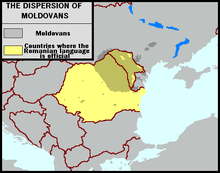Moldovans
The Moldovans (also called Moldovans ) are an ethnic subgroup of Romanians who live in what is now eastern Romania , the Republic of Moldova and Ukraine (mostly in Odessa Oblast and Chernivtsi Oblast ) and speak the Moldovan dialect (graiul moldovenesc) of the Romanian language . These areas formed the Principality of Moldova in the Middle Ages .
Number of Moldovans
The Romanian- speaking self-designation is moldovean (male) and moldoveancă (female). The total number of Moldovans is around 9 million people.
In Romania (2002): The Romanians in the districts: Bacău (688.719), Botoșani (447.426), Iași (800.997), Galați (604.753), Neamț (547.122), Suceava (662.980), Vaslui (449.796), Vrancea (380.364 ). Many Moldovans (from eastern Romania) have emigrated to other cities in Romania for economic reasons within the last 40 years (approx. 2 million) in Bucharest , Constan Consta , Timișoara , Petroșani and Brașov . A total of around 5.5 million Moldovans live in Romania.
In the Republic of Moldova (2004): 3,643,260 (of which 177,760 in Transnistria ).
In Ukraine (2001): 409,600, mainly in Chernivtsi Oblast (181,800), Odessa (123,800), Mykolaiv (13,100) and Kirovohrad (8,200). Another 82,700 Romanian Moldovans live in other oblasts of Ukraine.
In addition, many Moldovans emigrated to the other Soviet republics during the Soviet era, they now live in Russia (172,330), Kazakhstan (20,054), etc.
history
The political demarcation between the Moldovans from Romania and those from the former Soviet Union goes back to 1812. After one of the Russo-Ottoman wars, part of the Ottoman vassal state of Moldova was ceded to the Russian Empire. The area was part of the Russian Empire until 1917 as the Bessarabia Governorate. The Moldovans living in Bessarabia were therefore not involved in the formation of the Romanian state, which took place with the unification of the principalities of Moldova and Wallachia in 1859 and the later proclamation of the Kingdom of Romania in 1881. During the First World War, the area was occupied by the Central Powers from 1917 . The Sfatul Țării was formed as a provisional national assembly that declared union with Romania in 1918. After the Molotov-Ribbentrop Pact of 1939, the Soviet Union annexed the area in 1940. Romania then took part in the attack on the USSR in 1941 and occupied the area together with German troops until it was recaptured by the Red Army in 1944. In order to bind the won territory to the Soviet Union in the long term, the feeling of being in the country and community was artificially strengthened by simply calling the Moldavian language Moldavian and emphasizing the peculiarity of the Moldovans. Leonid Ilyich Brezhnev , who later became the leader of the CPSU , was General Secretary of the Moldovan Soviet Republic at the time and is said to have contributed significantly to this demarcation in his position.
language
All Moldovans speak the Moldovan dialect of the Romanian language . The official language in the Republic of Moldova, called Moldovan , is not a written form of the Moldovan dialect, as is often assumed, but the same form of the Romanian language that also serves as the official language in neighboring Romania ( Muntenesc ). Thus, the only difference compared to its western neighbor is the official naming of the language and the fact that it was still written in Cyrillic during the Bessarabia and Soviet times , while in the Principality of Romania a reorientation of the Romanian in 1868 from from Cyrillic to Latin script. Since 1989, Romanian has been taught in Latin script in schools in Moldova and the name of the material is no longer "Moldovan language", but "Romanian language". In Transnistria , the use of the Latin script is still not officially recognized by the separatist government (with the exception of six schools in which Romanian is taught using the Latin script).
Others
Living in Bessarabia until 1940 Bessarabian Germans called the Moldovans in their dialect Moldowaner .
See also
Individual evidence
- ↑ Mircea Mușat, Considerații privind urmările dominației și ingerințelor străine asupra evoluției istorice a poporului român în "Anale de Istorie", no. 2/1976, Bucureşti, pag 197-200
- ↑ История Республики Молдова. С древнейших времён до наших дней = Istoria Republicii Moldova: din cele mai vechi timpuri pină în zilele noastre / Ассоциация учёных Молдовы им. Н. Милеску-SPATARу. - изд. 2-е, переработанное и дополненное. - Кишинёв: Elan Poligraf, 2002. - С. 95. - 360 с. - ISBN 9975-9719-5-4 .
- ↑ История Республики Молдова. С древнейших времён до наших дней = Istoria Republicii Moldova: din cele mai vechi timpuri pină în zilele noastre / Ассоциация учёных Молдовы им. Н. Милеску-SPATARу. - изд. 2-е, переработанное и дополненное. - Кишинёв: Elan Poligraf, 2002. - С. 95. - 360 с. - ISBN 9975-9719-5-4 .
- ↑ Cristina Petrescu, "Contrasting / Conflicting Identities: Bessarabians, Romanians, Moldovans" in Nation-Building and Contested Identities, Polirom, 2001, p. 157.
literature
- Stefan Ihrig: Who are the Moldovans? Romanism versus Moldovanism in Historiography and School Books of the Republic of Moldova, 1991-2006 , ibidem-Verlag, Stuttgart 2008 (= Soviet and Post-Soviet Politics and Society; 76), ISBN 978-3-89821-466-7


